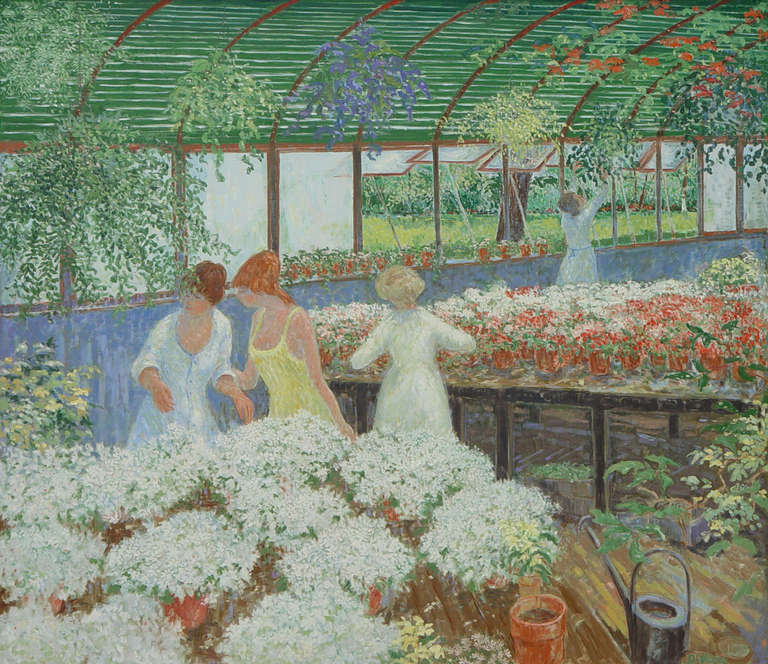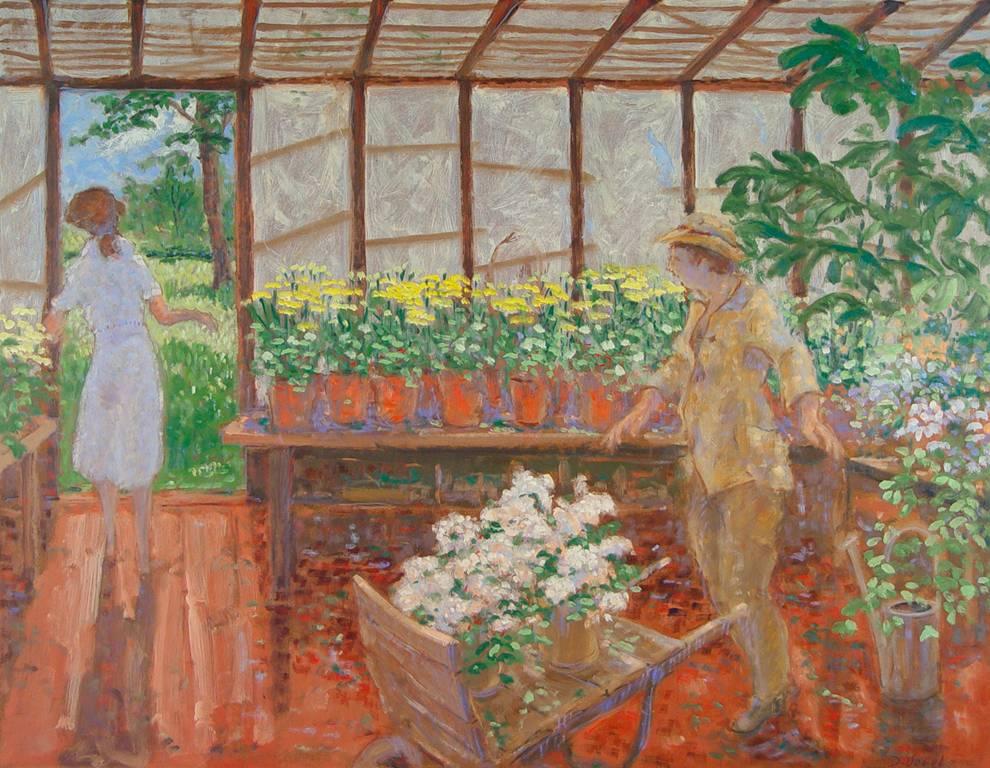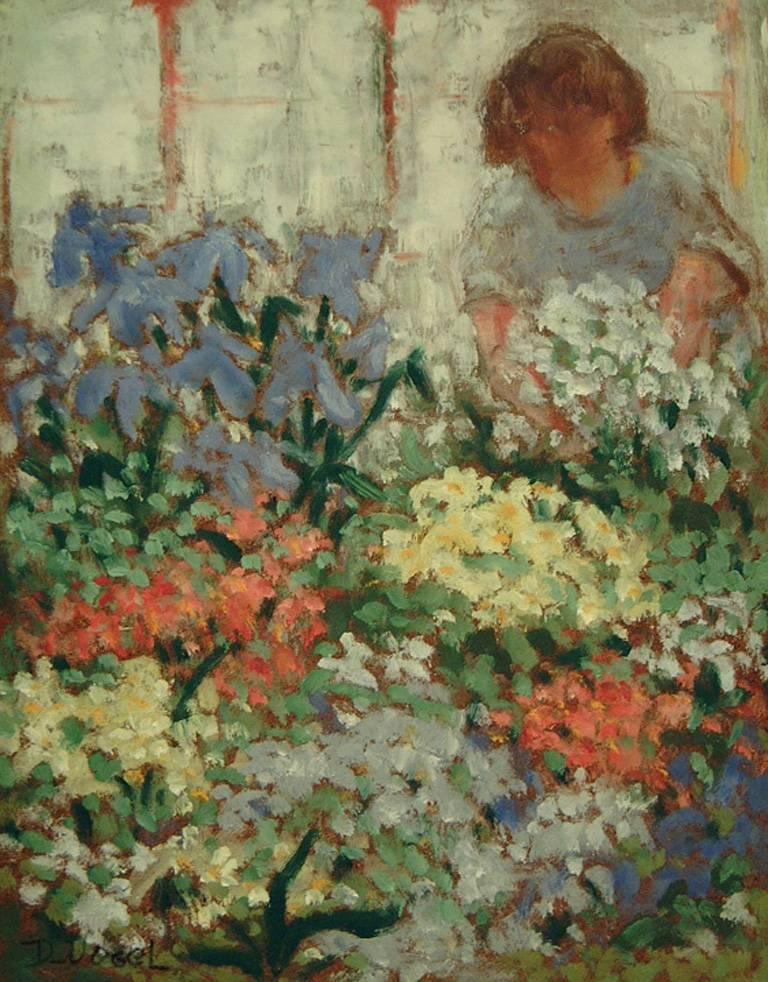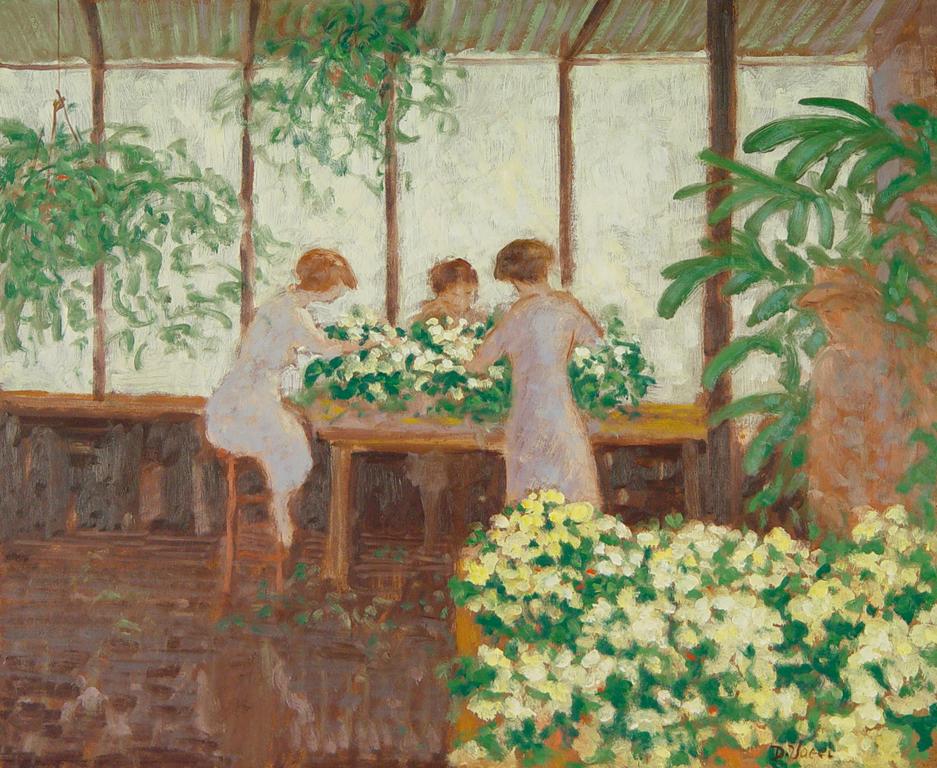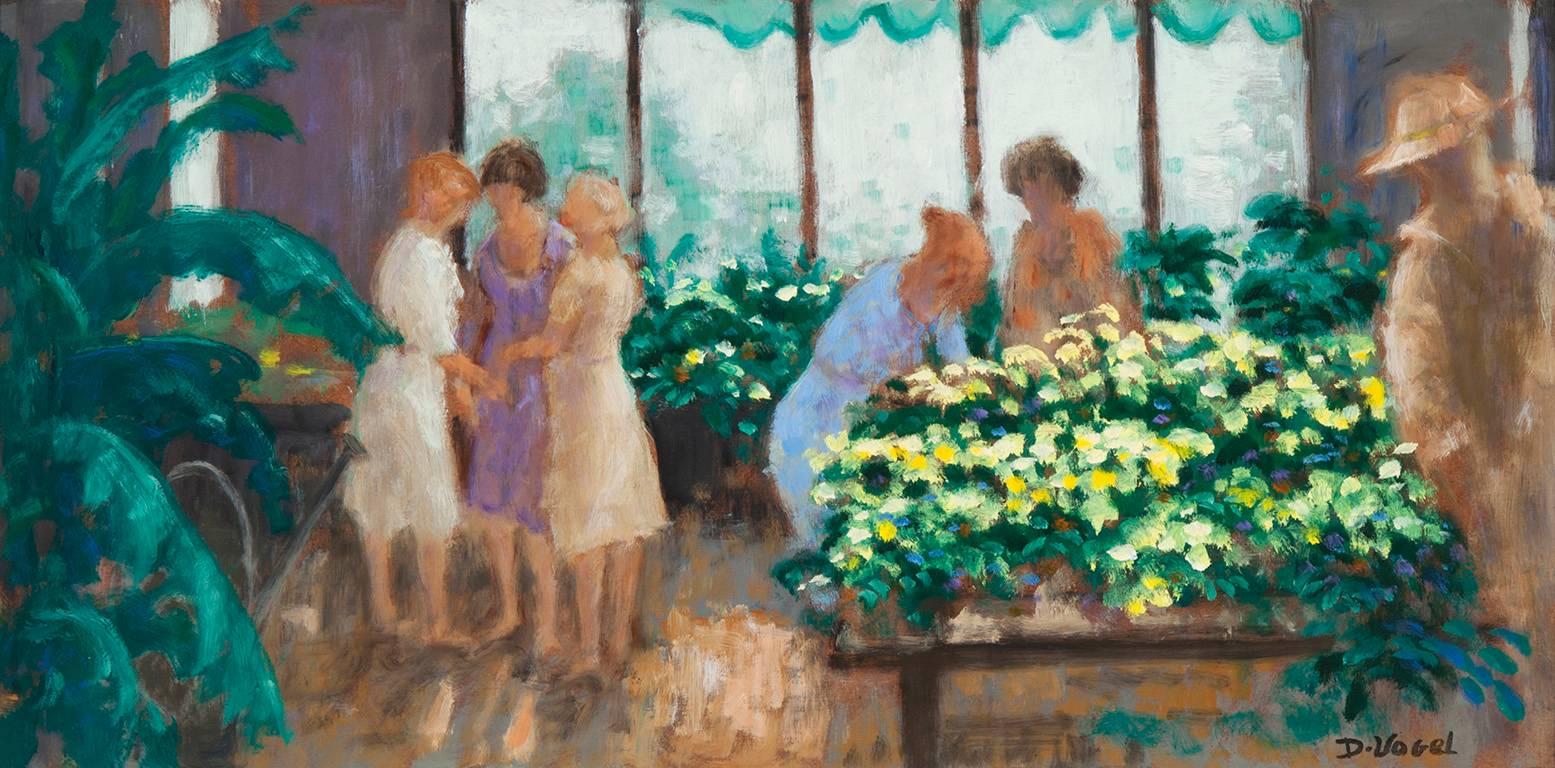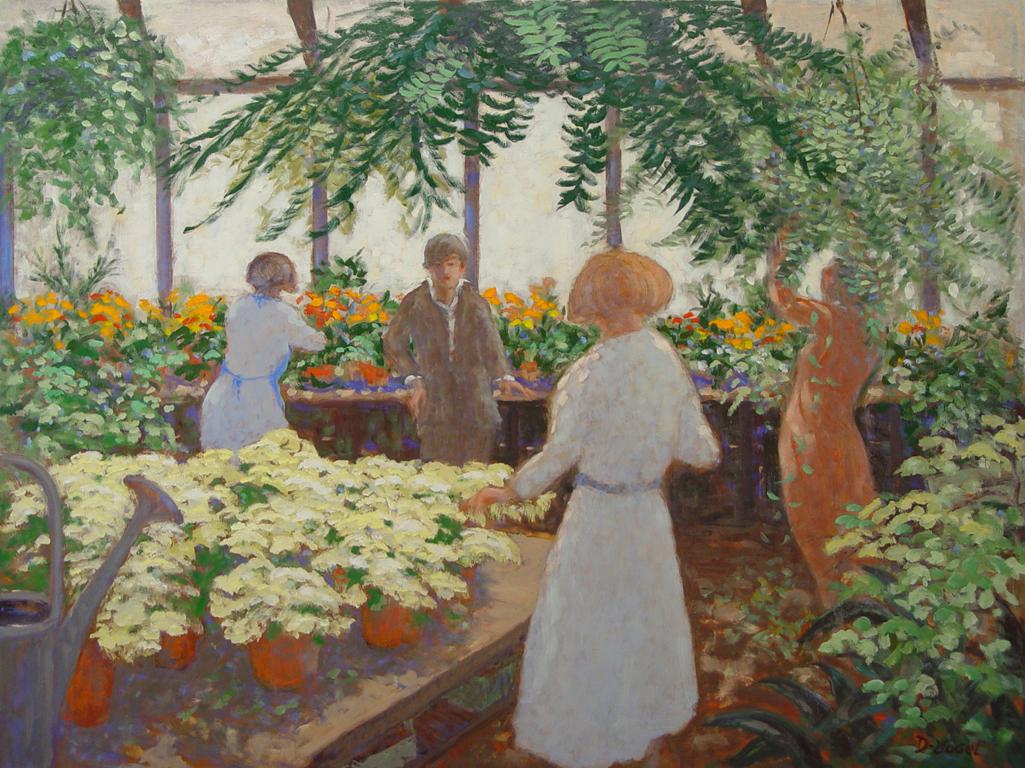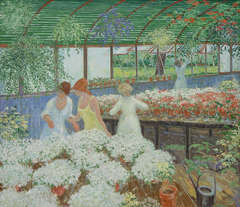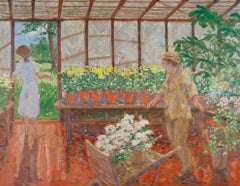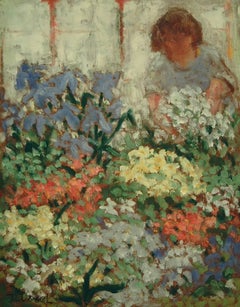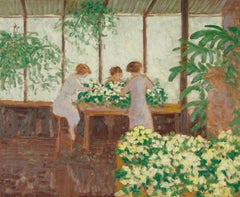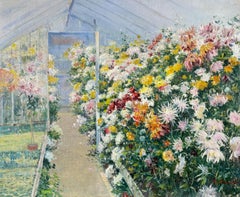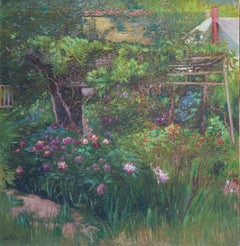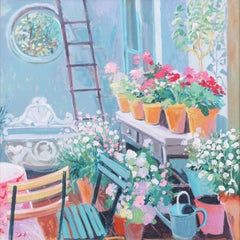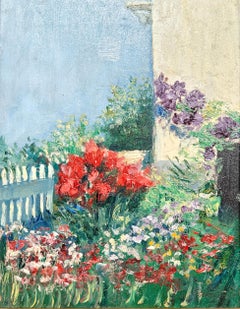Want more images or videos?
Request additional images or videos from the seller
1 of 4
Donald S. VogelFlower Shed1982
1982
$12,500
£9,495.79
€10,934.35
CA$17,882.51
A$19,615.39
CHF 10,114.92
MX$234,286.35
NOK 128,287.95
SEK 120,348.65
DKK 81,712.20
About the Item
The greenhouse became a favorite subject of Donald Vogel's in the 1980's. As Vogel reflected in the 1998 catalogue published for his traveling retrospective exhibition, "The greenhouse became the subject I returned to most often. Although I designed a greenhouse off the bedroom, my painted greenhouses are imaginary. Compositionally, the options are endless. The lines of the window panes and the architectural features contrast with the organic shapes of the plants and the ever-changing qualities of light streaming through the glass."
Donald Vogel’s paintings reflect his interest in seeking beauty in life and in sharing pleasure with his viewers. Vogel entreats us to "rejoice and celebrate each new day, knowing it is a gift in itself, and produce something of worth to be shared. That is the life that has served this artist's pilgrimage."
Donald S. Vogel has been a set designer and technical director in the theater, a fine art dealer, and a writer, but first and foremost he is a painter. From a young age he was intrigued by the possibilities of creating images. The excitement and pleasure derived from the act of creation continued to be the force that compelled him to paint throughout his life.
Born in Milwaukee, Wisconsin, Donald S. Vogel began his formal art training at the Witte Memorial Museum in San Antonio when he was seventeen. His training, under the watchful eye of Eleanor Onderdonk, was briefly interrupted by a move to Washington, DC , where he took drawing classes at The Corcoran School of Art . He returned to San Antonio to finish high school and continued studying under Onderdonk. After graduation, he moved to Chicago in 1936 to enroll in The School of the Art Institute of Chicago. In the Impressionist and Post-Impressionist rooms of the Institute, a new world opened up to him, one that would forever influence the direction of his work. He saw art that dealt with the effects of atmosphere and light. The subjects and techniques used by these painters conveyed a sense of happiness, exuberance, and pleasure, which offered a stark contrast to the world outside stifled by the Great Depression.
While studying at the Art Institute, Vogel roomed at the Artist Community House where many students lived. This environment served as a counterpoint to the academic training he received at the Institute. It afforded the students the freedom to discuss issues in contemporary art, and freely experiment with unconventional ideas and techniques. Most importantly, this fertile environment intensified Vogel's commitment to paint.
Feeling the pinch of the Depression, Vogel left the Art Institute in 1940, and was accepted on the WPA Easel Project. This allowed him the luxury of drawing and painting from dawn to dusk. The freedom to paint at all hours focused his interest on the seemingly endless variations of light and atmosphere. With unlimited use of a model, he produced thousands of figure drawings until, eventually freed from the necessity of working from life, he began to paint purely from his imagination.
In 1942, Vogel moved to Dallas. The previous year, while he was still living in Chicago, the Dallas Museum of Fine Arts had given Vogel a one-person show; in 1943, shortly after his arrival in Dallas, the DMFA gave him another. While working first as a set designer and then as technical director at the Dallas Little Theater, Vogel spent his free time at the easel. During the 1940's he gained recognition in the art community by promoting the work of fellow artists and winning coveted purchase awards and prizes in the Texas General and Allied Arts Exhibitions for his own paintings.
In 1951, Vogel and his wife Peggy, alongside Dallas arts patron Betty McLean, opened the Betty McLean Gallery. It was the first gallery in Texas to deal in modern art on an international level. In 1954, the Vogels moved to a five-acre site north of Dallas and opened Valley House Gallery. The new setting at Valley House deeply inspired Vogel, serving as a source for ideas, and providing a place of serenity and contemplation.
Vogel's work is characterized by his love of color, and his fascination with the changing qualities of light. A favorite subject, often revisited during the latter part of his career, is the greenhouse. He first experimented with this subject in 1976, and began using it in earnest in 1978. Having worked in a hothouse during his youth, he found it a natural subject for exploring the effects of atmosphere, light, and color. Like Monet's pond at Giverny, Vogel's greenhouses have become his signature: an imaginary place of endless fascination.
Vogel produced many catalogues for gallery artists but he had never written for himself. In 1989, he penned two autobiographical short stories and published them under the title Charcoal and Cadmium Red. He found writing to be as challenging a process as painting. During his eighth decade, he wrote and painted with equal intensity.
Donald S. Vogel's work is included in the following collections:
Art Institute of Chicago, Chicago, Illinois
Beaumont Museum of Fine Art, Beaumont, Texas
Charles Goddard Center, Ardmore, Oklahoma
Dallas Museum of Art, Dallas, Texas
Fine Arts Museum of the South, Mobile, Alabama
Ft. Worth Art Association, Ft. Worth, Texas
Old Jail Foundation, Albany, Texas
Panhandle-Plains Historical Museum, Canyon, Texas
Philadelphia Museum of Art, Philadelphia, Pennsylvania
Philbrook Art Center, Tulsa, Oklahoma
The Pennsylvania Trust, Radnor, Pennsylvania
Tyler Museum of Art, Tyler, Texas
Witte Museum, San Antonio, Texas
- Creator:Donald S. Vogel (1917-2004, American)
- Creation Year:1982
- Dimensions:Height: 48 in (121.92 cm)Width: 48 in (121.92 cm)
- Medium:
- Movement & Style:
- Period:
- Condition:
- Gallery Location:Dallas, TX
- Reference Number:Seller: A06791stDibs: LU2572242273
About the Seller
5.0
Recognized Seller
These prestigious sellers are industry leaders and represent the highest echelon for item quality and design.
Established in 1954
1stDibs seller since 2013
161 sales on 1stDibs
Typical response time: 16 hours
Associations
Art Dealers Association of America
- ShippingRetrieving quote...Shipping from: Dallas, TX
- Return Policy
Authenticity Guarantee
In the unlikely event there’s an issue with an item’s authenticity, contact us within 1 year for a full refund. DetailsMoney-Back Guarantee
If your item is not as described, is damaged in transit, or does not arrive, contact us within 7 days for a full refund. Details24-Hour Cancellation
You have a 24-hour grace period in which to reconsider your purchase, with no questions asked.Vetted Professional Sellers
Our world-class sellers must adhere to strict standards for service and quality, maintaining the integrity of our listings.Price-Match Guarantee
If you find that a seller listed the same item for a lower price elsewhere, we’ll match it.Trusted Global Delivery
Our best-in-class carrier network provides specialized shipping options worldwide, including custom delivery.More From This Seller
View AllGreenhouse in Bloom
By Donald S. Vogel
Located in Dallas, TX
The greenhouse became a favorite subject of Donald Vogel's in the 1980's. As Vogel reflected in the 1998 catalogue published for his traveling retrospective exhibition, "The greenhou...
Category
1970s American Impressionist Figurative Paintings
Materials
Oil
Storage Shed
By Donald S. Vogel
Located in Dallas, TX
The greenhouse became a favorite subject of Donald Vogel's in the 1980's. As Vogel reflected in the 1998 catalogue published for his traveling retrospective exhibition, "The greenhou...
Category
Late 20th Century American Impressionist Figurative Paintings
Materials
Oil, Panel
Many Colored Flowers
By Donald S. Vogel
Located in Dallas, TX
Donald S. Vogel has been a set designer and technical director in the theater, a fine art dealer, and a writer, but first and foremost he is a painter. From a young age he was intrig...
Category
20th Century American Impressionist Figurative Paintings
Materials
Oil, Panel
Pleasant Work (Greenhouse)
By Donald S. Vogel
Located in Dallas, TX
The greenhouse became a favorite subject of Donald Vogel's in the 1980's. As Vogel reflected in the 1998 catalogue published for his traveling retrospective exhibition, "The greenhou...
Category
Late 20th Century American Impressionist Interior Paintings
Materials
Oil, Panel
Greenhouse
By Donald S. Vogel
Located in Dallas, TX
Donald Vogel’s paintings reflect his interest in seeking beauty in life and in sharing pleasure with his viewers. Vogel entreats us to "rejoice and celebrate each new day, knowing it...
Category
Late 20th Century American Impressionist Figurative Paintings
Materials
Oil, Panel
Greenhouse Yellows
By Donald S. Vogel
Located in Dallas, TX
Donald Vogel’s paintings reflect his interest in seeking beauty in life and in sharing pleasure with his viewers. Vogel entreats us to "rejoice and celebrate each new day, knowing it...
Category
Late 20th Century American Impressionist Figurative Paintings
Materials
Oil, Panel
You May Also Like
Flowers in a Greenhouse
By Theodore Wendel
Located in Bryn Mawr, PA
Wendel was born in Midway, Ohio, and trained at the McMicken School of Design where he met and befriended Joseph DeCamp. Together, the two artists traveled to Munich in 1878 to study...
Category
Late 19th Century American Impressionist Landscape Paintings
Materials
Canvas, Oil
"Corner of my Garden" Leon Foster Jones, Impressionist, Blooming Spring Flora
Located in New York, NY
Leon Foster Jones
Corner of my Garden, 1902
Signed and dated lower left
Oil on canvas
26 x 25 inches
Provenance
Goldfield Galleries, Los Angeles, California
Private Collection, Virginia Beach, Virginia
Leon Foster Jones was a painter of landscapes, an etcher, a lithographer, and an educator. He was born in Manchester, New Hampshire, his father held the position of overseer in one of the hosiery mills in the Manchester area. In approximately 1901, he married Josephine Currier. During the initial years of their marriage, the couple resided in Concord, New Hampshire. They made Port Jefferson, Long Island, New York their permanent home in 1910, although the artist had begun working there as early as 1907.
Numerous sources indicate that throughout his life, Jones gained recognition primarily for his paintings and etchings featuring historical sites across Long Island. His artistic education included four years at the Cowles Art School in Boston, Massachusetts, where he studied under Joseph Rodefer DeCamp...
Category
Early 1900s American Impressionist Figurative Paintings
Materials
Oil, Canvas
'In the Potting Shed', Large Floral Oil, California College of Arts and Crafts
Located in Santa Cruz, CA
Signed lower left, 'DeVee' for Robert DeVee (American, 1940-2017) and painted circa 1995.
Robert DeVee first studied painting at the California College o...
Category
1990s Post-Impressionist Interior Paintings
Materials
Canvas, Acrylic
"A Sunny Corner" Eugenie M. Heller, Impressionist Garden Landscape In Bloom
Located in New York, NY
Eugenie M. Heller
A Sunny Corner, circa 1900
Signed lower right
Oil on board
10 1/2 x 8 1/2 inches
Eugenie M. Heller (1867 - 1952) was active/lived in New York, Massachusetts.
Heller studied with Weir, Whistler, Amen-Jean, Grasset and Rodin. Eugenie Heller...
Category
Early 1900s American Impressionist Figurative Paintings
Materials
Oil, Board
A Single Beloved Flower
By Shirley Cean Youngs
Located in Greenwich, CT
American b. 1939
Renowned Impressionist painter Shirley Cean Youngs is a native New Yorker who now lives on a family compound in Connecticut surrounded by nature and those she loves...
Category
2010s American Impressionist Figurative Paintings
Materials
Canvas, Oil
"Flowers, New Hope"
By Joseph Barrett
Located in Lambertville, NJ
Illustrated in "Joseph Barrett, The Prime Years 1970s - 1990s", pg. 56, plate #065.
Jim’s of Lambertville is proud to offer this artwork by:
Joseph Barrett (1936 – )
Joseph Barrett was born in Midland, North Carolina, in 1936 and studied at the Massachusetts College of Art in Boston and at the Tyler School of Art in Philadelphia. Barrett, now of Lahaska, Pennsylvania, has been painting his entire adult life. His favorite subjects include the landscape surrounding New Hope and many local landmarks often encompassing figures into his compositions. Barrett utilizes a heavy impasto and his palette bears similarities to that of Fern Coppedge and George Sotter. Barrett’s paintings are always found in unique and somewhat charming handmade frames designed by the artist and finished in metal leaf.
A living contemporary of the no longer living “New Hope School” impressionist painters, Joseph Barrett resides outside of New Hope above his old-fashioned antique shop and studio. Entering Barrett’s shop is like taking a step back in time. Inside this cluttered and dusty haven of treasures from the past, is a studio spanning only four by eight feet. This little studio, containing cans of old brushes...
Category
Late 20th Century American Impressionist Landscape Paintings
Materials
Canvas, Oil
